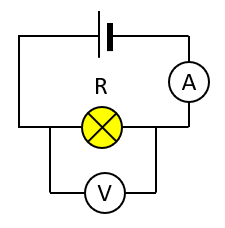Ohm’s Law - It’s not what you think
V = IR is valid, but it’s just not Ohm’s Law
Let’s quickly revise what you’ll find in most books and websites about Ohm’s Law:
V is potential difference (in volts, V)
I is current (in amperes, A) - I used to stand for electrical Intensity
R is resistance in (ohms, Ω) - Ω is a Greek uppercase letter ‘omega’ - the equivalent of a letter ‘o’ - ‘o’ for ohms
The most basic problem involves a simple circuit where you’re given two of these values and have to find the third.
For example in this circuit
The ammeter reads 2 amperes. The resistance of the bulb is 10 ohms.
What is the reading on the voltmeter?
We use
V = IR
V = 2 x 10
V = 20 volts
If we needed to find current or resistance, then we can use a triangle to work out how to find the unknown.


